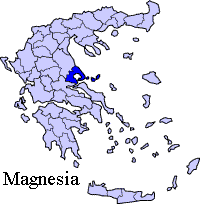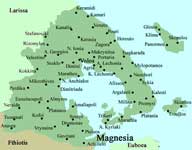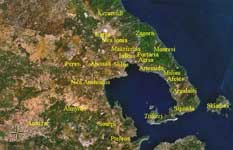|
|
Nea Anchialos () is a town of Magnesia prefecture. It is situated south of Volos and north of Almyros. It is placed on the national highway Athens-Lamia-Volos. On the east there is Pagassitikos bay and west-northwest it is surrounded by picturesque little hills. The whole area is 48 square kilometers and its population 7411 people (2001). Thanks to its picturesque, charming nature, clean seaside, the coexistence of peacefulness and the cosmopolitan life and mainly the clean environment and the hospitality of the local people, have made the town one of the biggest tourist resorts of the area. Nea Anchialos has dense vegetation, full of pine trees, vineyards, olive trees, almonds trees.
Two little hills, Kokkinovrahos and Mavrorahi, rise west-northwest, which attribute to our town its exquisite view of the clear waters of Pagassitikos bay and reveal the excellent laying out. The beautiful coasts of Nea Anchialos extend to 20 kilometers. There is a variety of beaches with the unique reddish sand (appropriate for sand-baths for people suffering from rheumatism).There is also golden sand as well as cliffs and pebbles. Small bays and ports, which are formed in certain areas, offer indisputably clear water, ideal for swimming, fishing and sea sports. Nea Anchialos is one of the most important towns of Magnesia prefecture due to its natural beauty and the remarkable archaeological findings. Built on the ruins of the ancient city of Pyrassos, of the Achaia Fthiotida. Homer provide us with information about the city, who mentions it in his list of ships (Iliad B695) together with Fylaki and Itona, which belonged to the kingdom of Protessilaos. According to Strabon (IX435), who discusses its topography, Pyrassos was 20 stadiums from the contemporary city Fthiotides Thives. In Pyrassos there was the famous temple of Demeter. There is a possibility that it has also been an important religious center of the area. The only excavation which took place in the hill southeast of Nea Anchialos proves that the city has been peopled since the earliest Neolithic period (6th millennium BC) by fishermen-agriculture's, who developed a remarkable civilisation. Pyrassos can only provide us with hypothetical information; an arm from an oversized statue, which came into light in 1965, was attributed to Demeter, the goddess adored by the inhabitants of the city. Maybe the most identical finding is a small piece of an ancient epigraph, discovered in the debris of the big Basilica D' with the name Pyrassos, clear proof that this is the spot where used to be the great city of Protessilaos and Demeter. Pyrassos ends in 217 BC when it was destroyed by Philip the 5th. In this debris developed later a new city, Fthiotides Thives. According to epigraphs, it took its name on the 2nd century AD and reached its cultural, spiritual and artistic peak during the Paleochristianic period until the 7th century. This fact justifies the term "Christianikae Thive". Long lasting excavations have brought into light a good number of buildings of the ancient city. There has been an effort to determine the course pf its wall which protected the city. The area surrounded by the was is about 600x480 meters. Until now there have been discovered ten important monuments and the ancient city:
However, outside the wall there are important buildings as well: The Basilica cemetery, the Basilica 5th, mansion of the 3-4th century by the sea, baths and extensive mosaics, another street with shops, cemeteries with arched graves engraved in side of the hill or underground arched graves with sarcophagus since the 3rd-6th century. The example above represent for the main part art in the area. The various mosaics and their extraordinary technique, make the city the most appropriate place to study that kind of decoration.
Nea Anchialos [Source] Travel Agencies
Nea Anchialos, Satellite image Division of the municipality
Prehistoric Settlement in the Mikrothebes (Mikrothives) junction, final neolithic period Persons
Sites of interest
 |
|
|||||||||||||||
|
|









